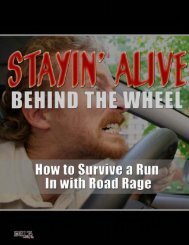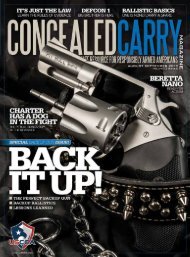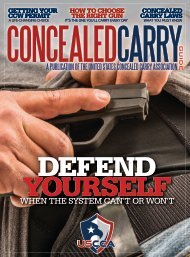Download This Issue - US Concealed Carry
Download This Issue - US Concealed Carry
Download This Issue - US Concealed Carry
Create successful ePaper yourself
Turn your PDF publications into a flip-book with our unique Google optimized e-Paper software.
name of article here<br />
How much time to spend sitting every day? How often do<br />
you train drawing your gun and shooting while seated?<br />
1. What type of gun will we use?<br />
2. Will we know what and where the<br />
target is just before we know we need to<br />
shoot?<br />
3. Will we know how many shots we<br />
need to fire?<br />
4. Will we need to assess our shots<br />
while we are shooting?<br />
5. Will we be on balance?<br />
6. Will we have time to prepare?<br />
7. Can we take a do over?<br />
8. Are we in danger?<br />
9. Will we have a set time to perform<br />
our shooting?<br />
Now go back and answer them again,<br />
but replace defensive shooting with<br />
hunting, practical competition shooting,<br />
shooting to measure your skill, recreational<br />
shooting, bull’s-eye competition<br />
shooting and defensive competition<br />
shooting. Did you get different answers?<br />
I know that I do.<br />
It is those different answers that lead<br />
us to the conclusion that defensive<br />
shooting is fundamentally different<br />
from other types of shooting and should<br />
be treated as such when we choose our<br />
gear, techniques and practice methods.<br />
The most important differences are<br />
in questions 2, 3, 5, 6, 8 and 9. These are<br />
the major differences between defensive<br />
shooting and shooting in typical training<br />
environments or competition (even<br />
so-called “defensive” competitions).<br />
In those settings, you usually know the<br />
answers to numbers 2 & 3. In competition,<br />
you know that your top two shots<br />
will be scored, so you need to fire two<br />
good shots or you need to hit each piece<br />
of steel once, for example. In training,<br />
you will often be told how many shots<br />
to fire in a string (though this is thankfully<br />
becoming less and less standard as<br />
private sector schools move to un-choreographed<br />
strings of fire as a default).<br />
In competition, you will usually be given<br />
some type of briefing or be allowed to<br />
see the course of fire prior to taking your<br />
turn. In training, you will often be told<br />
exactly what to shoot after a specific signal<br />
and then given the signal to execute<br />
the drill. Knowing the answers to these<br />
two questions changes everything about<br />
the way your brain executes the skills.<br />
For many years, we have made comparisons<br />
between defensive training<br />
and sports science. There are very well<br />
researched and established methods for<br />
training physical skills that are used in<br />
professional sports. Whether we are talking<br />
about swinging a golf club, throwing<br />
a ball or shooting a gun, we can very accurately<br />
control our body in a precise<br />
way under controlled conditions. We can<br />
get into a “zone” and execute complex<br />
motor skills on a signal or at our own<br />
pace because we can practice in close<br />
to the exact conditions and without any<br />
anticipation of significant difference in<br />
the conditions under which we will need<br />
to execute those skills in a game or competition.<br />
The problem is that without<br />
the answers to questions #2 and #3, we<br />
cannot practice exactly what we need to<br />
practice prior to the moment we need to<br />
execute the skill. Keep in mind, we can<br />
always practice the skill at a higher level<br />
than we are likely to need. In the training<br />
world, this is the route that many<br />
schools of thought have taken. Teach<br />
people target shooting skills, demand<br />
extreme levels of precision and proclaim<br />
that skill degradation and the natural<br />
urge to “go faster” under the circum-<br />
30<br />
<strong>US</strong>CONCEALEDCARRY.COM n CONCEALED CARRY MAGAZINE n MAY/JUNE 2011
















